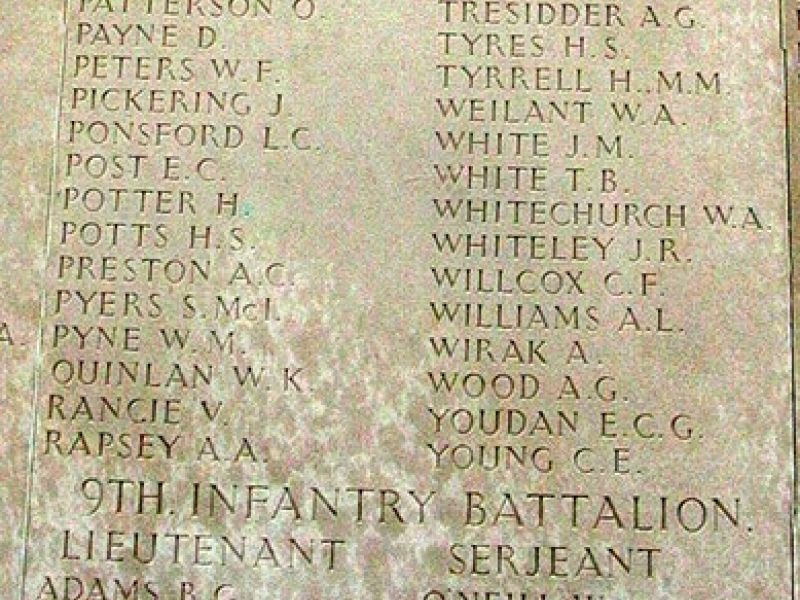Ernest Campbell Post
Ernest was born in Tintaldra, Victoria on the 15th of September 1889. He was the youngest of nine children of William Henry and Elizabeth Jane Thomson (née Inglis). He attended the Walwa State School (No. 2806) and, after leaving school, gained employment as a labourer in the district. Ernest’s father passed away when he was 15 years old.
Ernest enlisted at Royal Park in Melbourne on the 7th of January 1916. He was allocated the Regimental Number 5440 and placed into the 11th Reinforcements for the 24th Battalion. His first few weeks were spent with the 24th Depot Battalion at Royal Park. Early in March 1916 he transferred to the Broadmeadows Camp just outside of Melbourne. Ernest’s service records also include completed enlistment papers for November of 1915. There is no reason in his records as to why there are two attestation records.
After completing his initial training in Australia, Ernest embarked on HMAT A14 Euripides at Melbourne on the 4th of April 1916. Arriving at Suez on the 14th of May of that year, he was transferred to No 8 Training Battalion. Ernest remained in Egypt until the 31st of May when he embarked on HMT Huntsgreen and sailed to England with the rest of his unit. They arrived at Plymouth on the 12th of June after having an uneventful passage through the Mediterranean. A further three months training was undertaken in England before crossing the English Channel and making his way to the 1st Australian Division Base Depot at Etaples in France. He finally joined his battalion, the 8th, which were in reserve trenches near Ypres in Belgium on the 21st of September 1916.
In early March of 1917, the 8th Battalion was holding recently captured trenches after fighting German forces withdrawing towards stronger positions in the west. Ernest was a member of A Company HQ, along with another Corryong boy, James Rookie Wheeler. As the Company Commander, Lieutenant Bill Catron tried to remove a dagger embedded in the wall of a dugout, a huge explosion took place. Unfortunately the dagger had been booby trapped to a German mine which exploded when pulled from the wall. Five soldiers were killed, including Catron and Wheeler. Ernest was wounded by shrapnel.
He was immediately evacuated to the 1st Australian Field Ambulance and then moved through a number of medical units before arriving at the 7th Canadian General Hospital at le Treport two days after being wounded. Almost three weeks later Ernest was transferred to the 6th Convalescent Depot at Etaples. He returned to his unit on the 24th April.
Four months later he was admitted to the 2nd Australian Field Ambulance suffering from scabies. On the 7th of October he developed impetigo, a bacterial infection under the skin. He was transferred to the 25th General Hospital. Ernest would not rejoin his unit the 1st of November 1917. Two days later he was given almost three weeks leave, his first official leave since arriving in France.
1918 was not only known as the last year of the war, although those on the ground didn’t know that at the time, it also saw the emergence of the influenza pandemic. This would kill more people worldwide than four years of war. In mid June Ernest was admitted to the 8th Stationary Hospital with influenza. He survived the flu and rejoined his battalion in the field on the 16th of August 1918.
The battalion was having a short rest period after participating in the attack on Lihons, where they suffered heavy casualties. Four days after arriving back to his battalion, Ernest found himself marching with the rest of his battalion in full moonlight, as they made their way forward to participate in the next phase of the general advance. As the 8th Battalion was making their way forward, along with the 7th Battalion and twelve tanks, German artillery opened up in response to flares fired by their forward troops. Two 8th Battalion officers were killed and 30 other banks wounded. Although Australian artillery soon retaliated, stunning the Germans in their trenches, the advance lost its momentum and it became a bitter struggle between small parties of Australian infantrymen seeking out the German defenders.
By the end of the 23rd of August the Australians were in a strong position and they would go on to achieve complete success, with two members of the 8th Battalion being awarded the Victoria Cross, unfortunately posthumously. Amongst the dead was Private Ernest Post.
Ernest’s Red Cross File provides an eye-witness account of what happened to him;
“Killed in Action 23-8-18
Post was a private in A Company. 1st Platoon. 8th Battn. fair, tall, well built.
McLaren was a private in A Company. 1st Platoon. 8th Battn. fairly tall, medium build, darkish.
They were in the same Machine Gun Section in my Platoon, and were killed on the 23rd of August by a shell which landed in the midst of the Section. I was about 10 yards ahead. Five out of six in the Section were hit. McLaren and Post were killed outright. J. Sutton and S. Stoneman were in the same Section and are in Blighty [England] now. It was about 5.a.m. just after we hopped off. I went on and saw no more of them. It was in the attack at St Martin’s Wood. They were buried just off the left of where Capt Johnston was buried and about 2 or 3 chains further on.
Informant: - Mjr. Mc Crickard
A Company. 8th Battalion”
Records indicate that Ernest was buried at a spot 1200 yards south-south-east of Harbonnieres, France. Unfortunately, after the war, Ernests grave was unable to be located so officially he has no known grave. He is remembered on the Australian War Memorial Roll of Honour, the Villers-Bretonneux Memorial (Australian National Memorial - France) and the Walwa WW1 Roll of Honour. For his service during the First World War, he was awarded the British War Medal and the Victory Medal.
One of Ernest's brothers, Albert Gordon Post, also enlisted in the 1st AIF. Although wounded, gassed and hospitalised due to illness, he returned home in May of 1919. Albert also enlisted in the CMF (Citizens Military Force) serving on home duties during the 2nd World War.

 Stephen Learmonth
Stephen Learmonth